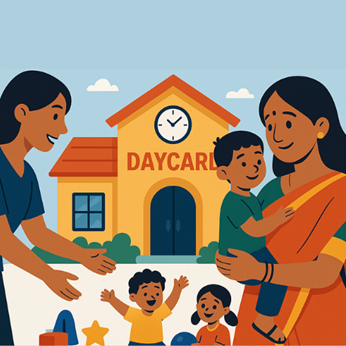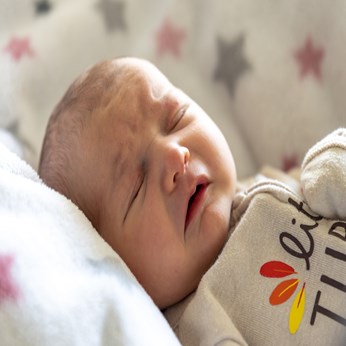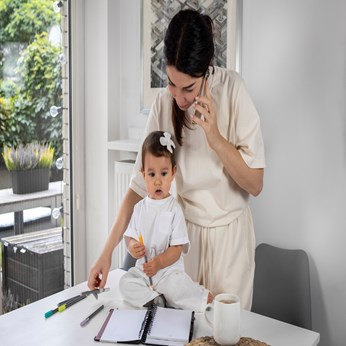Everything You Need To Know About The First Month Of A Baby
The sight of the newborn fills the parent’s minds with a lot of joy, but at the same time his/her mind is filled with doubts regarding the baby’s first few months. Most newborns spends most of his/her life sleeping in short stretches, with him/her going through new and rewarding experiences learning a lot by looking, hearing, moving and touching.
Here are a few things a newborn can do by the first 1 month:
The baby is able to recognize and distinguish your breast milk from those of other mothers. Also the newborn hears and recognizes his/her mother’s language; babies in the womb itself know when the mother’s own language is spoken and when she speaks another language.
Most babies are funny looking puffed face with eyes shut and fine body hair called lanugo; this is due to the baby spending 9 months in the womb and being smooched in its journey through the birth canal. Soon he/she will resemble the pretty baby you imagined.
Babies at birth can focus best at 20 to 30 centimeters; the distance adults instinctively put their face to talk to the baby. He/she cannot see clearly longer than this distance.
Babies cry a lot during the first few weeks; it is their way of communicating that they are uncomfortable due to hunger, cold or a dirty diaper. Your efforts will be soon rewarded with a smile or cooing around 6 to 8 weeks when the baby will show it when he/she is being comforted or held.
Your baby will start recognizing his/her parents in about 2 weeks. This process could be strengthened by loving and responding to the baby with feeding, changing, cuddling and comforting.

When the baby is a month and half he/she will start following slow moving objects, when it is the right time to introduce moving toys that are curvy and have high contrast. It would also help to place a black and white mobile above his cot. Faces are also ideal toys for the newborn.
High-pitch sounds and sing-song voices as most liked by babies; avoid loud sounds and use repetitive ones to soothe the baby. Sing and talk to the baby as much as possible and sing rhymes like ‘Round and round the garden’ with the same gentle stroking movements each time and sing and talk to him or her as far as possible. Your baby will enjoy being carried in a sling as you move about, especially if you talk to him as you go. All this contributes to be a valuable learning experience.
It is Ok to touch the soft spot or fontanel on the head and hair near it; the fontanel allows the baby to maneuver out of the birth canal. It may pulsate because it's directly over blood vessels covering the brain.
Lastly the doctors may offer various examinations of hearing, eyes, heart, hips testes, cataract and retinoblastoma, congenital heart disease, and developmental dysplasia of the hips just 3 days after birth. A similar examination is repeated at 6 to 8 weeks of age as some conditions can develop later.
Image Courtesy: Google
Take the next step toward your goals
Share your requirement and find the best care providers in your area
-
Looking for a caretaker’s job? Build your profile and get in touch with families in your vicinity.
-
Discover nannies, babysitters, cooks, housekeepers, pet sitters, and elder care under one roof.
-
Get all the support you need to run a successful care center.
-
Search for appropriate centers near you depending on your needs.
Care Corner Insights: Blog Library

Daycare Admissions in Cary, NC for New NRI Families: Documents, Health Records, and Start Dates
Moving to a new country is exciting but also comes with many responsibilities—especially when it comes to finding the right daycare for your little one. For new NRI (Non-Resident Indian) families settling in Cary, NC, understanding the daycare

Overnight Babysitters in Bellevue, WA for Business-Travelling NRI Parents: Safety & Policies
For many NRI parents living in Bellevue, WA, frequent business trips are a reality. While traveling, one of the biggest concerns is ensuring your children are safe, cared for, and emotionally supported during overnight stays. Overnight babysitters ca

Indian Home-Style Cooks in Queens, NY: Tiffin-Style Weekly Meal Prep from Your Kitchen
Queens, NY, is home to one of the most diverse food cultures in the country, and Indian cuisine holds a special place among families looking for authentic, comforting meals. While restaurant takeout is convenient, nothing compares to the taste and nu

Baby Sleep Problems: What is Sleep Regression and How to Handle It
If you’re a parent, you know that baby sleep is one of the greatest mysteries of life. One day your little one is snoozing like an angel, and the next day they’re suddenly waking up every hour, fussing, or refusing to nap. Before you panic, there’s a

What is Validation Therapy? A New Approach to Dementia Care
Caring for loved ones with dementia is one of the most emotionally challenging journeys a family can face. Traditional methods often focus on correcting memory lapses or redirecting confused thoughts—but that can sometimes lead to frustration, stress

What is a Part-Time Nanny and Do You Need One
Parenting is a beautiful journey, but let’s be honest—it can also be exhausting! Between work deadlines, household chores, and family responsibilities, sometimes there just aren’t enough hours in a day. That’s where part-time nannies step in, offerin

Part-Time Housekeeper Hiring in Alpharetta, GA: Weekly Schedules, Pricing, and Must-Do Tasks
Keeping a home spotless while balancing work, family, and personal commitments can be overwhelming. For families and professionals in Alpharetta, GA, hiring a part-time housekeeper is one of the most practical solutions. Whether you need help once a

Affordable Daycares in Irving, TX with Indian Menu Options: Parent Reviews & Enrollment Tips
Finding the right daycare for your little one is never an easy decision—especially if you’re looking for one that fits your budget and offers familiar food options like an Indian-inspired menu. For parents in Irving, TX, the good news is that several

Can Babies Sleep on Their Side? Tips for Safe Baby Sleep
When it comes to newborns, every parent worries about the smallest details—how they sleep, what they wear, even which way they turn their tiny heads. One common question that pops up is: “Can babies sleep on their side?” The short answer? Not recom

8 Benefits of Hiring a House Cleaner for Your Home
Let’s be honest — keeping a home sparkling clean while juggling work, family, and daily life can feel like a full-time job in itself. That’s where professional house cleaners step in, turning the chaos into calm. If you’ve been debating whether to br